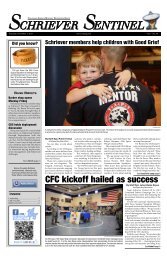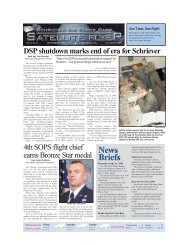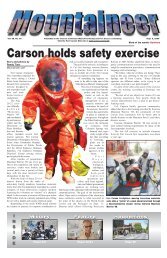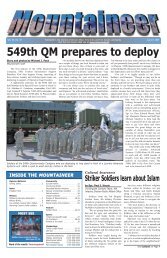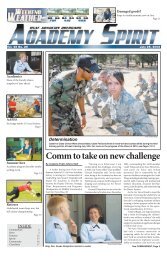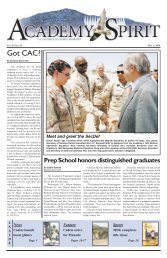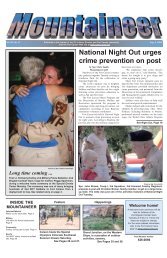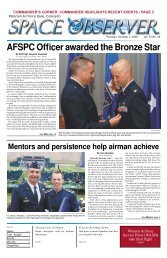March 29, 2013 - Colorado Springs Military Newspaper Group
March 29, 2013 - Colorado Springs Military Newspaper Group
March 29, 2013 - Colorado Springs Military Newspaper Group
You also want an ePaper? Increase the reach of your titles
YUMPU automatically turns print PDFs into web optimized ePapers that Google loves.
18 MOUNTAINEER — <strong>March</strong> <strong>29</strong>, <strong>2013</strong><br />
DPW<br />
improves<br />
forest<br />
health,<br />
safety<br />
“This program is a<br />
very effective tool<br />
to hold and control<br />
a wildfire from<br />
becoming large<br />
and catastrophic.”<br />
— Glen Silloway, Fort Carson fire chief<br />
For more information, call the DPW Environmental<br />
Division Forestry Section at 526-1692.<br />
By Dawn Beall and<br />
Leonard Cook<br />
Directorate of Public Works<br />
Environmental Division<br />
Massive pine beetle outbreaks and<br />
larger than normal wildland fires are<br />
all too common and widespread issues<br />
severely impacting <strong>Colorado</strong>’s forests<br />
and altering the mountain landscapes.<br />
Many factors have contributed to<br />
the dilemma of declining forest health.<br />
Decades of a fire suppression policy<br />
have created overcrowded forests and<br />
an increase of fire fuel in the forest.<br />
Natural fires, a significant component<br />
of the forest’s natural life cycle, have<br />
been altered to such an extent that<br />
today’s forests are overstocked and in<br />
poor health. Shifting climate conditions<br />
and an ongoing drought have created<br />
a perfect storm for insect infestation<br />
and catastrophic fire potential.<br />
Additional factors, such as the<br />
lack of a forest industry for using<br />
wood products and the introduction of<br />
many homes into the wildland urban<br />
interface have further exacerbated<br />
these forest issues.<br />
<strong>Colorado</strong> <strong>Springs</strong> residents<br />
learned just how close to home the<br />
potential for a major wildland fire is<br />
from last year’s Waldo Canyon Fire.<br />
The fire was the most destructive<br />
and expensive in <strong>Colorado</strong> history,<br />
consuming more than 18,000 acres,<br />
destroying 346 homes, causing the<br />
evacuation of 32,000 residents and<br />
claiming two lives.<br />
Since the fire, mitigation measures<br />
have been implemented by property<br />
owners and city, county, state and federal<br />
agencies. The thinning and removal<br />
of trees close to structures and creating<br />
or improving existing fire barriers<br />
have been the most effective means<br />
to control this hazardous situation.<br />
Fort Carson has been a proactive<br />
member in the community for years<br />
with its forest management and<br />
prescribed fire programs, completing<br />
many acres of forest thinning<br />
designed to improve forest health<br />
and reduce the wildfire threat.<br />
In 2012, the Directorate of Public<br />
Works Forestry Section developed a<br />
Leonard Cook, Directorate of Public of Works Wildland Fire Team member, conducts<br />
controlled prescribed burn operations to eliminate potential wildland fire fuel.<br />
plan and carried out additional forest<br />
thinning along the western boundary<br />
of Fort Carson along Highway 115.<br />
“We support the project,” said<br />
Mike Camp, Fort Caron Directorate<br />
of Plans, Training, Mobilization and<br />
Security range operations officer.<br />
“It is important to keep fires on Fort<br />
Carson and keep them from moving<br />
off the installation to the west — it<br />
also reduces the chance of the fire<br />
moving from the ground into the<br />
canopy and moving from tree to tree,<br />
which is not safe for firefighters.”<br />
The primary goals of the project,<br />
funded by the Army and the U.S.<br />
Department of Agriculture Forest<br />
Service, were to improve overall<br />
forest health and reduce the fuel<br />
load to aid in fire suppression.<br />
The main forestry management<br />
objective is to achieve the correct<br />
forest density that is sustainable with<br />
existing environmental conditions.<br />
Starting well before the Waldo<br />
Canyon Fire, specific areas on Fort<br />
Carson were identified for treatment,<br />
based on the high concentration of<br />
trees, forest health and the presence<br />
of forest insects and diseases, all of<br />
which creates intense inter-tree<br />
competition for growing space, water<br />
and nutrients. The result is a high<br />
level of stress among all living trees,<br />
which increases their susceptibility to<br />
many other environmental conditions,<br />
such as insects.<br />
Of particular concern is the pin<br />
engraver beetle. This beetle is a small<br />
insect — smaller than a grain of rice<br />
— that attacks weakened and stressed<br />
trees in large numbers, consuming<br />
and continuing their life cycle by<br />
feeding and laying eggs in the tree.<br />
The warming temperatures, below<br />
normal precipitation for many years<br />
and higher concentrations of these<br />
insects are all contributing to<br />
a visible decline of forests.<br />
Insect infestation alone has<br />
decimated vast acreages throughout<br />
the southwest and is quickly spreading<br />
on Fort Carson from the south to<br />
the north. The benefit of select tree<br />
thinning will be stronger trees that<br />
can capture more resources and better<br />
Photo by Danny Gray<br />
withstand insect infestation. Thinning<br />
also stimulates understory plant growth<br />
and improves wildlife habitat.<br />
Fire management is also<br />
improved by aggressive thinning in<br />
several key ways. Accessibility is<br />
improved for firefighters. Better<br />
defined fuel breaks provide defensible<br />
space to prevent spread beyond that<br />
point. Additionally, the firebreak is<br />
easier to maintain using smaller and<br />
more manageable prescribed burns.<br />
“This program is a very<br />
effective tool to hold and control a<br />
wildfire from becoming large and<br />
catastrophic,” said Glen Silloway,<br />
Fort Carson fire chief. “In the event<br />
of an approaching fire, this area<br />
along the west boundary will provide<br />
a much safer area for firefighters to<br />
aggressively contain the spread.”<br />
Unlike previous thinning projects,<br />
the slash, tops and small branches of<br />
removed trees, are being placed in<br />
piles and then burned. This is critical<br />
from the fire fuel perspective. The<br />
lower limbs will be removed on trees<br />
to limit the possibility of ground fires<br />
spreading into the canopy of the trees.<br />
All wood four riverbed inches in<br />
diameter and larger that is cut is used<br />
to support the Fort Carson Firewood<br />
Program, which has benefited many<br />
active duty and civilian families in<br />
the community.<br />
Fort Carson Fire Department<br />
officials have obtained the necessary<br />
permits to burn more than 300<br />
slash piles.<br />
In February, members of Station<br />
34 and the DPW Wildland Fire Team<br />
started prescribed burn operations,<br />
which will continue into the spring.<br />
The fire prescription for the operation<br />
was specific in addressing smoke<br />
dispersal, exact weather conditions,<br />
fire behavior and resources on scene.<br />
The DPW Forestry Section will<br />
continue to manage the forest by thinning,<br />
clearing the understory vegetation<br />
and removing fire fuels. These<br />
proactive measures will benefit the<br />
forest by safeguarding valuable natural<br />
resources, reducing the fire danger<br />
and contribute to the safety of Fort<br />
Carson’s neighbors and firefighters.



